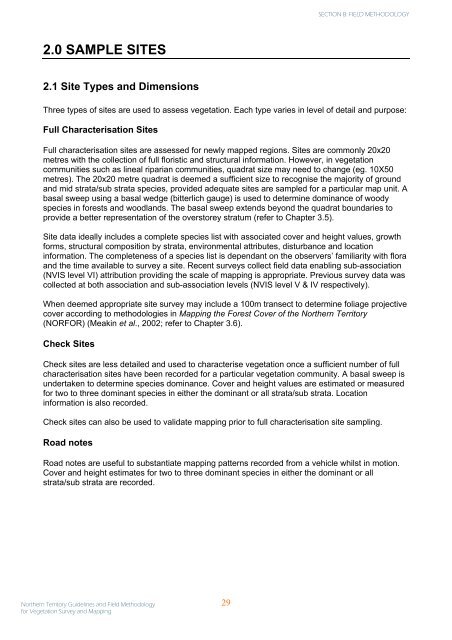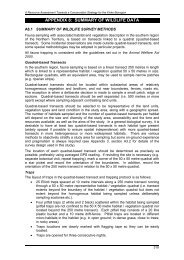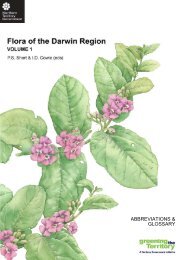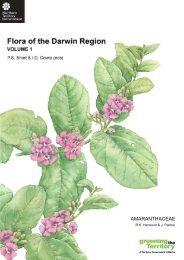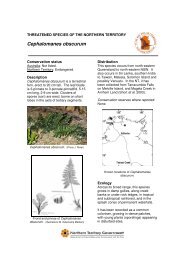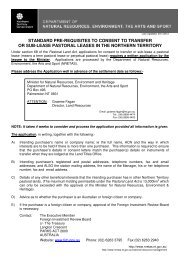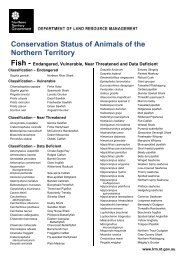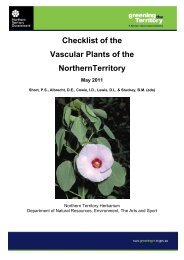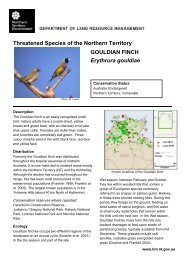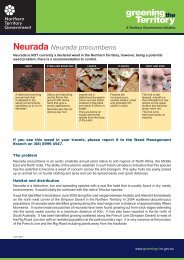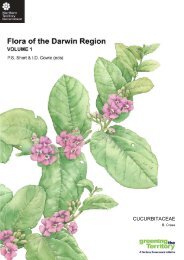Guidelines and Field Methodology for Vegetation Survey and Mapping
Guidelines and Field Methodology for Vegetation Survey and Mapping
Guidelines and Field Methodology for Vegetation Survey and Mapping
Create successful ePaper yourself
Turn your PDF publications into a flip-book with our unique Google optimized e-Paper software.
SECTION B: FIELD METHODOLOGY<br />
2.0 SAMPLE SITES<br />
2.1 Site Types <strong>and</strong> Dimensions<br />
Three types of sites are used to assess vegetation. Each type varies in level of detail <strong>and</strong> purpose:<br />
Full Characterisation Sites<br />
Full characterisation sites are assessed <strong>for</strong> newly mapped regions. Sites are commonly 20x20<br />
metres with the collection of full floristic <strong>and</strong> structural in<strong>for</strong>mation. However, in vegetation<br />
communities such as lineal riparian communities, quadrat size may need to change (eg. 10X50<br />
metres). The 20x20 metre quadrat is deemed a sufficient size to recognise the majority of ground<br />
<strong>and</strong> mid strata/sub strata species, provided adequate sites are sampled <strong>for</strong> a particular map unit. A<br />
basal sweep using a basal wedge (bitterlich gauge) is used to determine dominance of woody<br />
species in <strong>for</strong>ests <strong>and</strong> woodl<strong>and</strong>s. The basal sweep extends beyond the quadrat boundaries to<br />
provide a better representation of the overstorey stratum (refer to Chapter 3.5).<br />
Site data ideally includes a complete species list with associated cover <strong>and</strong> height values, growth<br />
<strong>for</strong>ms, structural composition by strata, environmental attributes, disturbance <strong>and</strong> location<br />
in<strong>for</strong>mation. The completeness of a species list is dependant on the observers’ familiarity with flora<br />
<strong>and</strong> the time available to survey a site. Recent surveys collect field data enabling sub-association<br />
(NVIS level VI) attribution providing the scale of mapping is appropriate. Previous survey data was<br />
collected at both association <strong>and</strong> sub-association levels (NVIS level V & IV respectively).<br />
When deemed appropriate site survey may include a 100m transect to determine foliage projective<br />
cover according to methodologies in <strong>Mapping</strong> the Forest Cover of the Northern Territory<br />
(NORFOR) (Meakin et al., 2002; refer to Chapter 3.6).<br />
Check Sites<br />
Check sites are less detailed <strong>and</strong> used to characterise vegetation once a sufficient number of full<br />
characterisation sites have been recorded <strong>for</strong> a particular vegetation community. A basal sweep is<br />
undertaken to determine species dominance. Cover <strong>and</strong> height values are estimated or measured<br />
<strong>for</strong> two to three dominant species in either the dominant or all strata/sub strata. Location<br />
in<strong>for</strong>mation is also recorded.<br />
Check sites can also be used to validate mapping prior to full characterisation site sampling.<br />
Road notes<br />
Road notes are useful to substantiate mapping patterns recorded from a vehicle whilst in motion.<br />
Cover <strong>and</strong> height estimates <strong>for</strong> two to three dominant species in either the dominant or all<br />
strata/sub strata are recorded.<br />
Northern Territory <strong>Guidelines</strong> <strong>and</strong> <strong>Field</strong> <strong>Methodology</strong><br />
<strong>for</strong> <strong>Vegetation</strong> <strong>Survey</strong> <strong>and</strong> <strong>Mapping</strong><br />
29


